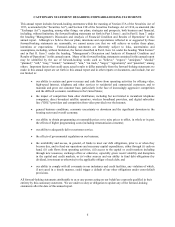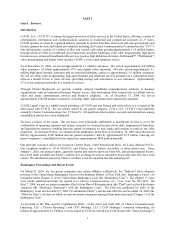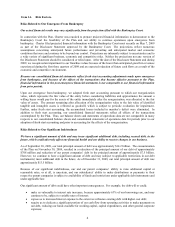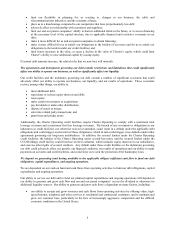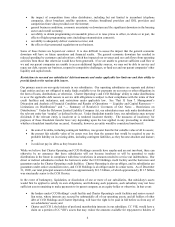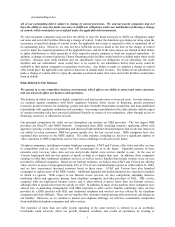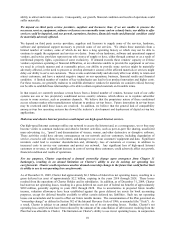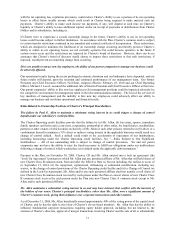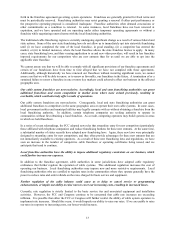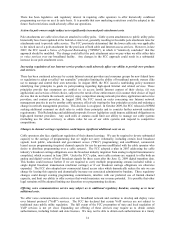Charter 2009 Annual Report Download - page 11
Download and view the complete annual report
Please find page 11 of the 2009 Charter annual report below. You can navigate through the pages in the report by either clicking on the pages listed below, or by using the keyword search tool below to find specific information within the annual report.
8
increasing competition. Based on internal estimates and excluding telephone companies, as of December 31, 2009,
we are aware of traditional overbuild situations impacting approximately 8% to 9% of our estimated homes passed,
and potential traditional overbuild situations in areas servicing approximately an additional 1% of our estimated
homes passed. Additional overbuild situations may occur in other systems.
In order to attract new customers, from time to time we make promotional offers, including offers of temporarily
reduced price or free service. These promotional programs result in significant advertising, programming and
operating expenses, and also may require us to make capital expenditures to acquire and install customer premise
equipment. Customers who subscribe to our services as a result of these offerings may not remain customers
following the end of the promotional period. A failure to retain customers could have a material adverse effect on
our business.
Mergers, joint ventures, and alliances among franchised, wireless, or private cable operators, DBS providers, local
exchange carriers, and others, may provide additional benefits to some of our competitors, either through access to
financing, resources, or efficiencies of scale, or the ability to provide multiple services in direct competition with us.
In addition to the various competitive factors discussed above, our business is subject to risks relating to increasing
competition for the leisure and entertainment time of consumers. Our business competes with all other sources of
entertainment and information delivery, including broadcast television, movies, live events, radio broadcasts, home
video products, console games, print media, and the Internet. Technological advancements, such as video-on-
demand, new video formats, and Internet streaming and downloading, have increased the number of entertainment
and information delivery choices available to consumers, and intensified the challenges posed by audience
fragmentation. The increasing number of choices available to audiences could also negatively impact advertisers’
willingness to purchase advertising from us, as well as the price they are willing to pay for advertising. If we do not
respond appropriately to further increases in the leisure and entertainment choices available to consumers, our
competitive position could deteriorate, and our financial results could suffer.
Our services may not allow us to compete effectively. Additionally, as we expand our offerings to include other
telecommunications services, and to introduce new and enhanced services, we will be subject to competition from
other providers of the services we offer. Competition may reduce our expected growth of future cash flows which
may contribute to future impairments of our franchises and goodwill.
Economic conditions in the United States may adversely impact the growth of our business.
We believe that the weakened economic conditions in the United States, including a continued downturn in the
housing market over the past year and increases in unemployment, have adversely affected consumer demand for
our services, especially premium services, and have contributed to an increase in the number of homes that replace
their traditional telephone service with wireless service thereby impacting the growth of our telephone business and
also had a negative impact on our advertising revenue. These conditions have affected our net customer additions
and revenue growth during 2009 and contributed to the franchise impairment charge incurred in 2009. If these
conditions do not improve, we believe the growth of our business and results of operations will be further adversely
affected which may contribute to future impairments of our franchises and goodwill.
We face risks inherent in our telephone and commercial businesses.
We may encounter unforeseen difficulties as we increase the scale of our service offerings to businesses. We sell
video, high-speed data and network and transport services to businesses and have increased our focus on growing
this business. In order to grow our commercial business, we expect to increase expenditures on technology,
equipment and personnel focused on the commercial business. Commercial business customers often require
service level agreements and generally have heightened customer expectations for reliability of services. If our
efforts to build the infrastructure to scale the commercial business are not successful, the growth of our commercial
services business would be limited. Continued growth in our residential telephone business faces risks. The
competitive landscape for residential and commercial telephone services is intense; we face competition from
providers of Internet telephone services, as well as incumbent telephone companies. Further, we face increasing
competition for residential telephone services as more consumers in the United States are replacing traditional
telephone service with wireless service. We depend on interconnection and related services provided by certain
third parties for the growth of our commercial business. As a result, our ability to implement changes as the services
grow may be limited. If we are unable to meet these service level requirements or expectations, our commercial
business could be adversely affected. Finally, we expect advances in communications technology, as well as
changes in the marketplace and the regulatory and legislative environment. Consequently, we are unable to predict



